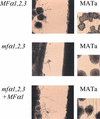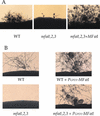Pheromones stimulate mating and differentiation via paracrine and autocrine signaling in Cryptococcus neoformans
- PMID: 12455985
- PMCID: PMC118021
- DOI: 10.1128/EC.1.3.366-377.2002
Pheromones stimulate mating and differentiation via paracrine and autocrine signaling in Cryptococcus neoformans
Abstract
Cryptococcus neoformans is a pathogenic fungus with a defined sexual cycle involving haploid MATalpha and MATa cells. Interestingly, MATalpha strains are more common, are more virulent than congenic MATa strains, and undergo haploid fruiting in response to nitrogen limitation or MATa cells. Three genes encoding the MFalpha pheromone were identified in the MATalpha mating-type locus and shown to be transcriptionally induced by limiting nutrients and coculture with MATa cells. The MFalpha1, MFalpha2, and MFalpha3 genes were mutated, individually and in combination. MATalpha strains lacking MFalpha pheromone failed to induce morphological changes in MATa cells. Pheromoneless MATalpha mutants were fusion and mating impaired but not sterile and mated at approximately 1% the wild-type level. The pheromoneless MATalpha mutants were also partially defective in haploid fruiting, and overexpression of MFalpha pheromone enhanced haploid fruiting. Overexpression of MFa pheromone also enhanced haploid fruiting of MATalpha cells and stimulated conjugation tube formation in MATa cells. A conserved G-protein activated mitogen-activated protein kinase signaling pathway was found to be required for both induction and response to mating pheromones. The MFalpha pheromone was not essential for virulence of C. neoformans but does contribute to the overall virulence composite. These studies define paracrine and autocrine pheromone response pathways that signal mating and differentiation of this pathogenic fungus.
Figures






Similar articles
-
Characterization of the MFalpha pheromone of the human fungal pathogen cryptococcus neoformans.Mol Microbiol. 2000 Dec;38(5):1017-26. doi: 10.1046/j.1365-2958.2000.02213.x. Mol Microbiol. 2000. PMID: 11123675
-
A homolog of Ste6, the a-factor transporter in Saccharomyces cerevisiae, is required for mating but not for monokaryotic fruiting in Cryptococcus neoformans.Eukaryot Cell. 2005 Jan;4(1):147-55. doi: 10.1128/EC.4.1.147-155.2005. Eukaryot Cell. 2005. PMID: 15643070 Free PMC article.
-
Molecular analysis of CPRalpha, a MATalpha-specific pheromone receptor gene of Cryptococcus neoformans.Eukaryot Cell. 2002 Jun;1(3):432-9. doi: 10.1128/EC.1.3.432-439.2002. Eukaryot Cell. 2002. PMID: 12455991 Free PMC article.
-
Signal transduction cascades regulating mating, filamentation, and virulence in Cryptococcus neoformans.Curr Opin Microbiol. 1999 Aug;2(4):358-62. doi: 10.1016/S1369-5274(99)80063-0. Curr Opin Microbiol. 1999. PMID: 10458985 Review.
-
On the origins of congenic MATalpha and MATa strains of the pathogenic yeast Cryptococcus neoformans.Fungal Genet Biol. 1999 Oct;28(1):1-5. doi: 10.1006/fgbi.1999.1155. Fungal Genet Biol. 1999. PMID: 10512666 Review.
Cited by
-
Biogenesis of the Saccharomyces cerevisiae pheromone a-factor, from yeast mating to human disease.Microbiol Mol Biol Rev. 2012 Sep;76(3):626-51. doi: 10.1128/MMBR.00010-12. Microbiol Mol Biol Rev. 2012. PMID: 22933563 Free PMC article. Review.
-
Calcineurin-binding protein Cbp1 directs the specificity of calcineurin-dependent hyphal elongation during mating in Cryptococcus neoformans.Eukaryot Cell. 2005 Sep;4(9):1526-38. doi: 10.1128/EC.4.9.1526-1538.2005. Eukaryot Cell. 2005. PMID: 16151246 Free PMC article.
-
RNA biology and the adaptation of Cryptococcus neoformans to host temperature and stress.Wiley Interdiscip Rev RNA. 2014 May-Jun;5(3):393-406. doi: 10.1002/wrna.1219. Epub 2014 Feb 4. Wiley Interdiscip Rev RNA. 2014. PMID: 24497369 Free PMC article. Review.
-
Multiple Applications of a Transient CRISPR-Cas9 Coupled with Electroporation (TRACE) System in the Cryptococcus neoformans Species Complex.Genetics. 2018 Apr;208(4):1357-1372. doi: 10.1534/genetics.117.300656. Epub 2018 Feb 14. Genetics. 2018. PMID: 29444806 Free PMC article.
-
Glucosamine stimulates pheromone-independent dimorphic transition in Cryptococcus neoformans by promoting Crz1 nuclear translocation.PLoS Genet. 2017 Sep 12;13(9):e1006982. doi: 10.1371/journal.pgen.1006982. eCollection 2017 Sep. PLoS Genet. 2017. PMID: 28898238 Free PMC article.
References
-
- Alspaugh, J. A., L. M. Cavallo, J. R. Perfect, and J. Heitman. 2000. RAS1 regulates filamentation, mating and growth at high temperature of Cryptococcus neoformans. Mol. Microbiol. 36:352-365. - PubMed
-
- Alspaugh, J. A., R. C. Davidson, and J. Heitman. 2000. Morphogenesis of Cryptococcus neoformans, p. 217-238. In J. F. Ernst and A. Schmidt (ed.), Dimorphism in human pathogenic and apathogenic yeasts, vol. 5. Karger, Basel, Switzerland. - PubMed
Publication types
MeSH terms
Substances
Grants and funding
LinkOut - more resources
Full Text Sources
Molecular Biology Databases

